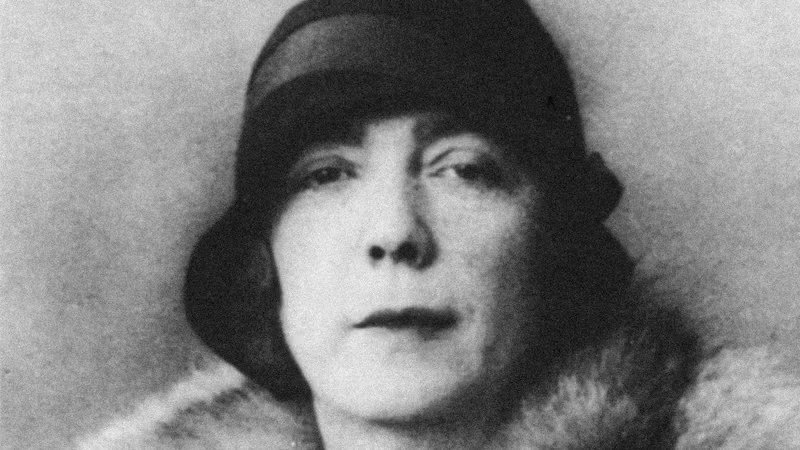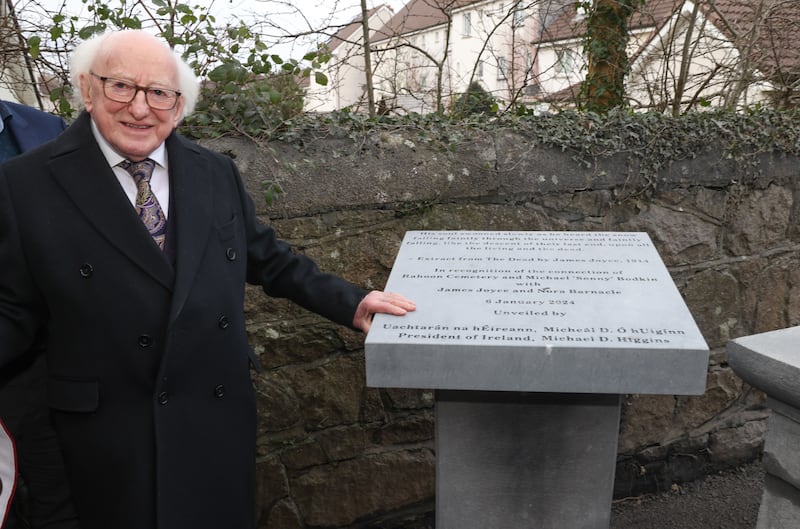“The time had come for him to set out on his journey westward,” thinks Gabriel in James Joyce’s The Dead. It is a journey towards the dying of the sun, where the night begins; but it also symbolises a return to the roots of Irishness, and to Nora Barnacle’s past. Back in Galway, Nora had had her sweethearts before Jim, and one of them, Michael Bodkin, was to become an obsession for Joyce.
On January 16th, President Michael D Higgins honoured Joyce scholar Fritz Senn, director of the James Joyce Zurich Foundation, with a Presidential Distinguished Service Award. Three days before, on January 13th, the 83rd anniversary of Joyce’s death, he had unveiled a plaque at Bodkin’s grave in Rahoon cemetery; and last summer, a plaque remembering Lucia Joyce was unveiled in Zurich at the Joyce family grave in Fluntern.
The people Joyce met or knew of were of paramount importance in the development of his art; and in their own ways, both Bodkin and Lucia were crucial in his attempt to transubstantiate experience and turn it into the stuff literature is made of.
The genius of Lucia lies at the heart of the creative language in Finnegans Wake. Joyce did all he could to have his beloved daughter’s mental condition cured, including consultations with Carl Jung, who coincidentally shared a birthday with Lucia: July 26th. (We know that Joyce was very attentive to the mystery value of dates: Ulysses had to be born, like him, on February 2nd (1922), and again by February 2nd (1939) he had to receive the first copy of the Wake.)
READ MORE
By the same token, Bodkin’s shadow allows for unique autobiographical readings of The Dead, starting from the ambiguity of its title, plural and singular at the same time. It refers to both the community of the departed and to a specific person. For Joyce, who was familiar with King James’s Bible, knew well that there, in John 11: 41, speaking of Lazarus we read: “Then they took away the stone from the place where the dead was laid.”
This is how secrets are hidden in Joyce’s writing, but it’s not the only way. Bodkin was another Lazarus, and we find him in the annotations to Joyce’s Exiles. There we read something truly uncanny: “Moon: Shelley’s grave in Rome ... Graveyard at Rahoon by moonlight where Bodkin’s grave is.”
Why mention Rome?
Rome was for him a graveyard-like city. He described the neighbourhood of the Coliseum as “an old cemetery”, and mimicking the American accent, spelt Rome as “Rawhm”, which might even remind one of the sound of Rahoon.
The connection becomes explicit in Joyce’s poem She Weeps over Rahoon, written in Trieste in 1913. Joyce had been in Galway in the summer of 1912, his last visit to Ireland. In that poem the rain is “softly falling” just as the snow is at the end of The Dead, the story written in Trieste in 1907 but born in his mind, like Ulysses, during his short sojourn in the Italian capital.

While in Rome, he went to the cemetery, though it is not clear whether he visited the Protestant one, where Shelley’s ashes are, or the monumental one, Verano, a place surrounded by many drinking places he certainly enjoyed.
Rome is also very important as the symbolic space of exile. In fact, in his play, the couple Richard and Bertha lived there for 10 years after leaving Ireland.
He calls it “dearome” and “Jeromesolem” in the Wake, where Bodkin is also present in various ways, first of all as a reference to Hamlet’s “bare bodkin”, meaning of course “dagger” but also “penis” (the slang meaning is attested in the English language since 1623).
The word “bodkin” is always ambiguous in the Wake, such as here: “They’re playing thimbles and bodkins”. It’s a reference to the British army, called “the thimble and bodkin army” in Cromwell’s time for, when the parliament in London was gathering an army, women who wanted to help brought silver thimbles and bodkins. However, it’s also Nora’s Michael, for the sentence before reads: “The dead giant manalive!”, and the one after: “Clan of the Gael”. Bodkin is a dormant spectre in Joyce’s texts, but one who can suddenly arise from his grave.
What about Ulysses? Is Bodkin there at all? To answer this question, we need to look at other ways in which Joyce conveys secret meanings.
Names are at times hidden behind acronyms in his works, such as with the Wake’s protagonists, HCE (Here Comes Everybody) and ALP (Anna Livia Plurabelle). In Ulysses we had Stephen Dedalus remind himself of “books you were going to write with letters for titles”, and Bloom thinking on Sandymount strand: “All these rocks with lines and scars and letters”.
But can single letters have meanings? Joyce thought they were significant, for they are the atoms of language. Thus, it’s not surprising that Michael Bodkin, the young man with whom he was “betrayed in absence” by Nora, shares initials with the arch-betrayer in Ulysses: Molly Bloom. (To be sure, they are the same initials also of Marion Bruère, the wife of Alfred Henry Hunter, the first model of Leopold Bloom.)
Joyce was a true believer in Giordano Bruno’s “coincidence of the contraries”, which makes for a fusion of end and beginning: life and death, for example. This is also symbolised by the fact that M and B, in reverse order, are the first and last letters of Leopold’s surname; and he is a possible betrayer, too, judging by his various flirtations.

Those two letters, whatever the order, have multiple meanings. They are also the initials of Stephen’s betrayer, Buck Mulligan, modelled on Oliver St John Gogarty, whose son was named Oliver Duane Odysseus, by the way. And Gogarty was himself an MB: Medicinae Baccalaureus, or a BM: Bachelor of Medicine.
Bodkin’s ghost haunts Ulysses in secret ways. For example, Mulligan opens the book by mimicking the Mass with his “Introibo ad altare Dei”. But in the 15th episode he turns it into an occult affair by chanting “Introibo ad altare diaboli”, as if he is kicking off a farcical Black Mass (B and M again).
This occult explanation might also suggest another direction: those letters could point to theosophist Madame Blavatsky, the inspirer of many occultist societies. She is mentioned in the book alongside other “Dublin hermetists”, as Joyce called people such as AE (George Russell). In this light, the fact Ulysses is set on June 16th (1904) looks like a funny coincidence, for the Dublin Hermetic Society of Yeats and Russell also opened on June 16th (1885).
Joyce tried to evoke and revive the ghost of Bodkin in strange ways because that boy remained close to his own heart too, not just Nora’s. For, as he had written in the Exiles notes: “She weeps over Rahoon, too, over him whom her love has killed, the dark boy whom, as the earth, she embraces in death and disintegration. He is her buried past, her life”.
Enrico Terrinoni is the author of a book on Joyce in Rome (Su tutti i vivi e i morti, 2022) and one on Joyce and Svevo (La vita dell’altro, 2023)















